Connecting Your Printer to an iPad: A Comprehensive Guide
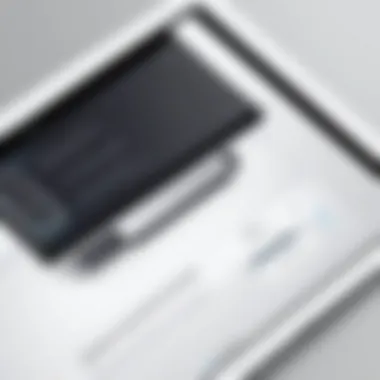
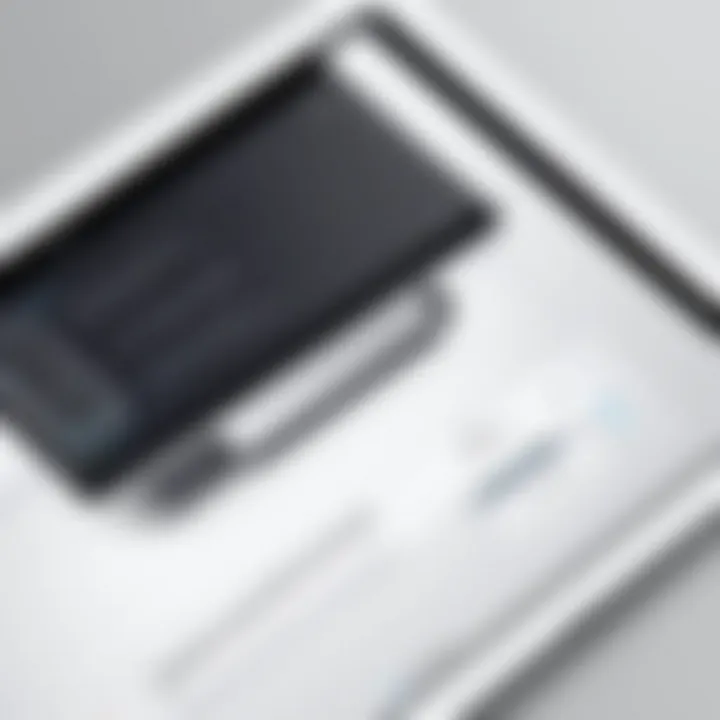
Intro
In an increasingly digital age, the ability to connect devices is essential. One crucial connection is between printers and mobile units like the iPad. Understanding how to link your printer with an iPad can greatly streamline your workflow, whether for personal or professional use. This guide aims to demystify the printing process on iPads, covering various compatible printing technologies, the methods for connection, and troubleshooting tips to address common printing problems. Harnessing this knowledge will enhance your printing experience and optimize the device capabilities you possess.
Overview of the Technology
When discussing printing from an iPad, two primary technologies come into play: AirPrint and Wi-Fi Direct. Each offers distinct advantages and limitations depending on your specific printer model and user needs.
Key specifications
- AirPrint: This Apple feature allows users to print wirelessly without needing to install drivers. AirPrint functions with most major printer brands, including HP, Canon, and Epson. To use AirPrint, both the iPad and printer must be connected to the same Wi-Fi network.
- Wi-Fi Direct: Not all printers have AirPrint capability. Wi-Fi Direct provides an alternative by enabling direct connections between the printer and the iPad without the need for a router. This feature can improve printing speed and reliability, especially in environments with many devices connected to the network.
Unique selling points
- User-Friendly Interface: Both AirPrint and Wi-Fi Direct maintain an intuitive user interface that simplifies the printing process. Users can expect straightforward setup and minimal technical expertise to initiate prints.
- Versatility: These technologies are compatible with a range of printer models. Users can select printers based on their specific needs, whether that is high-quality color printing or more economical black-and-white options.
Design and Build Quality
While not directly related to connecting an iPad to a printer, understanding the design and build quality of your printer can influence your choice. A well-built printer not only enhances the ease of use but also offers longevity and reliability over time.
Material used
Printers vary in materials from plastic to metal constructions. Higher-end models often utilize metal components for durability, while budget-friendly options may have more plastic parts. It's essential to consider the build material, especially if the printer will be used frequently.
Ergonomics and usability
User experience is paramount. Printers designed with ergonomic settings, such as easy-to-reach buttons and a clear display, make it easier to operate. The usability extends to the setup required for connecting to devices like iPads. A straightforward setup usually reflects a well-thought-out design.
"Choosing the right printer can significantly enhance your productivity and satisfying printing experience."
These initial sections provide a foundation for understanding how to connect your printer to an iPad effectively. The following sections will delve deeper into the specific methods of connection, practical applications, as well as troubleshooting techniques.
Prelims to Printer Connectivity
Understanding how to connect printers to an iPad is crucial in today’s digital landscape. Many users rely on portable devices for productivity, and the ability to print directly from an iPad can greatly enhance workflow efficiency. The integration of printing capabilities with mobile technology has numerous benefits, helping users streamline tasks and improve accessibility to needed documents.
The need for printer connection arises from various scenarios. For instance, students often require printed materials for presentations or studies. Business professionals may need to produce contracts or reports quickly. Understanding the ways to connect your iPad with a printer empowers you to respond to such needs effectively.
This guide elaborates on several aspects of printer connectivity specific to iPads. Knowing how different printers work with iPads, understanding compatibility, and learning configurations are essential. These elements foster a seamless printing experience. Furthermore, as printing technologies evolve, being well-informed will enable users to adapt and optimize the new features available on their devices.
Understanding the Need for Printer Connection
The ability to print documents directly from your iPad can significantly impact productivity. Users increasingly depend on mobile technology for various tasks, including document creation. When a printer is accessible, it allows for a more fluid work process. Moreover, the capabilities of the iPad in terms of document editing and image manipulation further establish the need for printing.
Users are often on the move. Without a reliable means to print, essential documents might remain in digital form, which can be a limitation. Thus, connecting a printer is not just a matter of convenience; it embodies a necessary integration of hardware and software that supports modern workstyles.
Overview of iPad Printing Solutions
There are several solutions available for printing from an iPad. Each method has its advantages and shortcomings, tailored to fit different user needs.
- AirPrint: A built-in feature that simplifies connecting printers compatible with Apple devices. It is user-friendly and requires minimal configuration.
- Wireless Printers: They connect to a Wi-Fi network, allowing printing without physical wires. This method maximizes flexibility within home or office environments.
- USB Printers with Adapters: By using adapters, users can connect traditional printers to their iPads. While this might need additional hardware, it expands compatibility options.
- Third-Party Apps: Certain applications enhance printing capabilities, enabling additional customization for users.
Understanding these options can help you decide the best approach for your specific needs. Each solution comes with distinct characteristics, aiding various scenarios and user preferences.
This comprehensive exploration of printer connectivity provides the foundation for future sections. Users should feel empowered to investigate their options, ensuring they select a method that aligns with their requirements.
Types of Printers Compatible with iPad
Understanding the variety of printers compatible with the iPad helps ensure a seamless printing experience. Different printing technologies offer unique features and functionalities. By choosing the right printer, users can enhance their workflows, be it for home, school, or office tasks. In this section, we delve into three main types of compatible printers: wireless printers, USB printers with adapters, and AirPrint-compatible printers.
Wireless Printers
Wireless printers have become a favored choice among iPad users for their convenience and ease of use. These devices connect through Wi-Fi, allowing users to print documents and images from their iPads without any physical connection. This ability significantly reduces clutter and enhances mobility.
One major benefit of wireless printers is the capability to print from multiple devices. Once connected to the same network, any compatible device, including iPads, laptops, and smartphones, can send print jobs. This flexibility is particularly invaluable in environments where several users need to access the printer.
However, it is essential to ensure that the wireless printer is compatible with iOS. Checking the printer’s specifications can save time and frustration. Not all wireless printers can efficiently communicate with the iPad, so look for those explicitly mentioned to work with Apple devices.


USB Printers with Adapters
While many users prefer wireless solutions, USB printers remain prevalent. They connect directly to a computer as traditional printers do. To connect a USB printer to an iPad, users need an adapter, specifically the Lightning to USB Camera Adapter. This lets the iPad recognize the printer.
Setting up a USB printer can be straightforward. First, acquire the necessary adapter, then connect the printer to the iPad using this adapter. After establishing the connection, users can usually adjust printer settings or preferences through the iPad itself.
It is important to note that not all USB printers will work seamlessly with iPads. Users must verify compatibility before investing in or connecting a USB printer. Always check if your specific printer model supports Direct USB connection.
AirPrint-Compatible Printers
AirPrint is an Apple technology that allows iPad users to print wirelessly to compatible printers without the need for additional drivers or software. This feature is built into many modern printers from various brands.
The primary advantage of AirPrint is its simplicity. Users can print directly from apps such as Photos, Safari, or Pages with just a few taps. The convenience of not needing complex setup processes makes AirPrint a strong choice for those who prioritize ease of use.
Another aspect of AirPrint is that it supports various media sizes and types, including photos, documents, and more. Users can customize print settings like color and paper type directly from their iPads. Before purchasing a printer, confirm that it has AirPrint capability, as this enhances the overall user experience.
"Choosing the right type of printer enhances your printing experience and streamlines tasks for efficient output."
Preparing Your iPad for Printer Connection
Connecting your printer to an iPad involves several critical steps. By focusing on the preparation of your iPad, you can ensure a smooth and efficient printing process. This preparation primarily includes verifying compatibility and updating the operating system to align with the printer’s requirements.
A well-prepared iPad minimizes frustration. It helps avoid delays during the printing task and reduces the chances of encountering errors when attempting to connect. In short, taking the time to set up your iPad properly enhances the overall experience.
Checking iOS Version Compatibility
The first step in preparing your iPad for connection is to check the iOS version. Each printer, especially those that support AirPrint, has specific iOS version requirements. If your iPad runs on a version below the printer’s requirement, the connection will fail.
To check your iPad’s iOS version, follow these steps:
- Open the Settings app.
- Tap on General.
- Select About.
- Find the Software Version entry.
Make a note of this version. If you see that your iOS is outdated, consider updating it. Connect your device to Wi-Fi. Then,
- Go back to Settings.
- Tap General again.
- Select Software Update and see if an update is available.
Keeping your device updated improves security, efficiency, and compatibility with peripheral devices.
Verifying Printer Compatibility with iOS
Once you have ensured that your iPad is running at least the necessary iOS version, the next step is to verify whether your printer is compatible with the iOS system. Not all printers can work seamlessly with iPads.
Most modern printers have the specifications provided by their manufacturers. Look for terms like "AirPrint compatible" or "iOS support" in the printer’s documentation or on the manufacturer’s website. If the printer supports AirPrint, it usually means it will work without additional software. Here is what to consider:
- Brand: Some brands, such as HP, Canon, and Epson, have a significant range of printers with compatibility options.
- Models: Even within brands, specific models may not support all features on iOS. Check individual model specifications.
- Driver Requirements: Some printers may require you to install specific drivers. This is less common, especially for AirPrint-enabled devices.
By following these steps, you will gain confidence in your iPad’s printing capabilities. This preparation lays the groundwork for a more seamless and engaging experience.
Connecting a Wireless Printer to iPad
Connecting a wireless printer to your iPad is a significant aspect of modern printing solutions. This process not only provides convenience but also exemplifies the efficiency of wireless technology in current devices. A wireless printer allows users to print directly from their iPads without the restrictions of tangled cables or complex setups. This capability is particularly valuable in environments where mobility and flexibility are key.
The ease of use associated with wireless printing cannot be overstated. By eliminating the need for traditional connections, users can quickly send print jobs from anywhere in their home or office, as long as they are connected to the same network. Additionally, the majority of newer printers support various wireless technologies, further enhancing compatibility with devices like the iPad.
Setting Up Your Wireless Printer
The first step when connecting a wireless printer to your iPad is setting up the printer itself. This usually involves following the manufacturer's instructions to ensure proper initialization. Most wireless printers come with a control panel or mobile app that simplifies this process. It is essential to connect the printer to your Wi-Fi network, as this is crucial for the iPad to locate the printer during the connection process.
- Unbox and Position: After unboxing, place the printer in a location where you plan to use it.
- Power On: Connect it to a power source and turn it on.
- Connect to Wi-Fi: Use the printer’s control panel or mobile app to input your Wi-Fi credentials.
Ensuring the printer is connected to the Internet with a stable connection will make the entire setup process smoother.
Configuring Wi-Fi Settings on Your iPad
Once your printer is successfully set up and connected to the Wi-Fi, the next task is configuring the Wi-Fi settings on your iPad. This step means confirming that the iPad is on the same network as the printer, which is paramount for linking devices effectively.
- Open Settings: Tap the Settings icon on your iPad.
- Select Wi-Fi: Choose the Wi-Fi menu from the left-hand column.
- Connect to the Same Network: Make sure your iPad is connected to the same Wi-Fi network that you configured for the printer. If not, select the correct network and enter the password.
A unified network ensures that the devices can communicate efficiently, which minimizes delays and connectivity issues during printing.
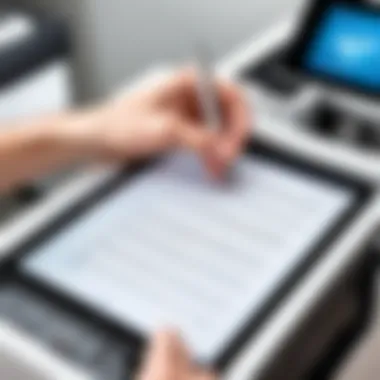
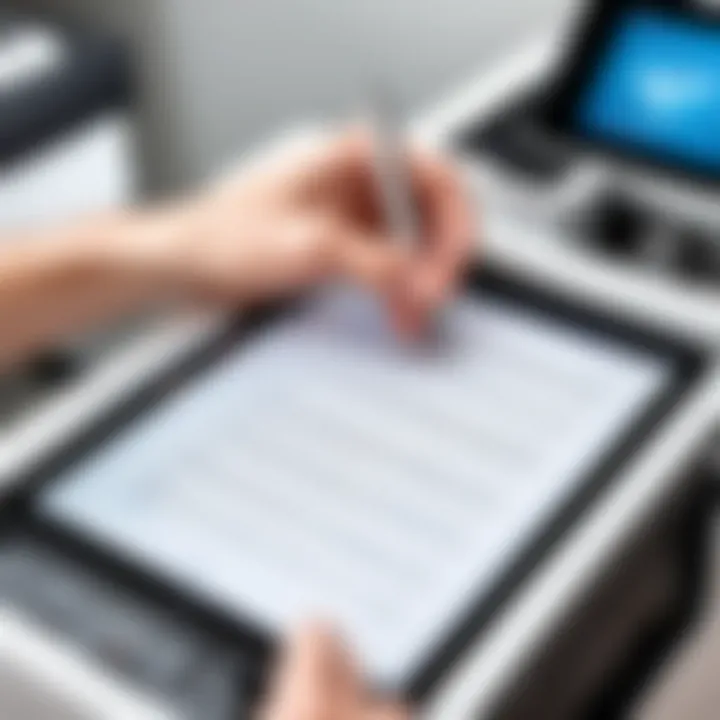
Adding the Printer to iPad
The final step in connecting your wireless printer is adding it to your iPad. This action allows your iPad to recognize the printer across the network. Here’s how to do it:
- Open an App: Launch an app that supports printing, such as Photos, Pages, or another similar application.
- Select Print: Choose the document or image you want to print and find the share or export option, which usually leads to the print menu.
- Choose Printer: Tap on the 'Select Printer' option. This action should show a list of available printers that are on the same network.
- Select Your Printer: Find and tap on your wireless printer from the list.
- Customize Options: If needed, customize settings such as the number of copies or range of print sizes before executing the print command.
Connecting your iPad to a wireless printer enhances convenience and efficiency, allowing seamless printing straight from your device.
Now, you are ready to execute print jobs with ease and efficiency, fully integrating your iPad into your printing workflow.
Connecting a USB Printer to iPad
Connecting a USB printer to your iPad is a practical solution for those who prefer a direct connection to print documents, photos, and other content with ease. Despite the growing popularity of wireless printing options, USB connections can still offer benefits in terms of stability and speed. This section discusses the essential components needed for a successful setup, steps to establish a connection, and preferences settings that enhance your printing experience.
Necessary Adapters for USB Printing
Before attempting to connect your USB printer to your iPad, you need to have the right adapters. Most commonly, iPads do not have a standard USB port, so an adapter is crucial. The Apple Lightning to USB Camera Adapter is one of the most recommended options. It allows you to connect USB devices directly to your iPad.
Alternatively, if your iPad has a USB-C port, you can use the USB-C to USB Adapter. It's vital to check the compatibility of your iPad model with the adapter you plan to use. This might include verifying your iPad's port type to ensure efficient connection.
- Apple Lightning to USB Camera Adapter
- USB-C to USB Adapter
By using these adapters, you can easily connect various printers that have standard USB cables. Ensure your adapter is genuine or certified to prevent potential issues.
Establishing the USB Connection
To establish a connection between your iPad and the USB printer, follow these step-by-step instructions:
- Connect the Adapter: Plug your adapter into the iPad.
- Attach the Printer’s USB Cable: Insert the USB cable from your printer into the adapter.
- Power on the Printer: Ensure the printer is turned on and ready to accept print jobs.
Once connected, your iPad should recognize the printer. If the connection is successful, the printer's name will appear under the printing options in compatible apps such as Pages or Photos. If not, check all connections to ensure they are secure.
Setting Printer Preferences on iPad
Once your USB printer is connected, configuring the printer preferences allows for a more tailored experience. To do this, follow these steps:
- Open an App: Launch an app on your iPad that supports printing.
- Access Print Options: Tap the share icon or the print button to access the print options.
- Select Your Printer: Choose the USB printer from the list of available printers.
- Adjust Settings: Here you can set preferences such as number of copies, layout, or color options.
- Initiate Printing: Finally, tap on print to send the document to your printer.
Additionally, it's a good idea to regularly check and maintain the printer settings on the iPad. Be sure not too miss firmware updates from both the printer manufacturer and Apple, as these can enhance printing efficiency and compatibility.
Following these steps ensures a smooth process for printing directly from your iPad to a USB printer, allowing you to execute tasks efficiently.
Using AirPrint Feature
AirPrint technology plays a significant role in enhancing the printing experience for iPad users. This feature simplifies the process of printing documents and images wirelessly, eliminating the need for complex setups or connections. AirPrint's seamless integration with iOS devices ensures that users can quickly access printing options directly from their apps. This section will explore what AirPrint is, its benefits, and how it facilitates printing from various applications, providing necessary insights for users looking to maximize their printing capabilities.
What is AirPrint?
AirPrint is a built-in feature of Apple’s iOS devices. It allows users to print content directly from their iPad without needing to install additional software or drivers. Compatible printers recognize AirPrint signals over Wi-Fi, making the process straightforward. Users simply select the printing option from their device, choose the AirPrint-enabled printer, and send the document to print. This capability simplifies tasks and can enhance productivity for both home and office environments.
Benefits of Using AirPrint
Implementing AirPrint into your printing workflow comes with various advantages:
- Convenience: Users can print from anywhere within the Wi-Fi network range, eliminating the restrictions of cable connections.
- Speed: Printing is often faster with AirPrint since it bypasses the need to set up print queues or connected devices.
- Quality: AirPrint optimizes print quality, ensuring that all colors and details reflect positively in the printed output.
- Compatibility: Many printers on the market today are AirPrint-enabled, offering a wide range of choices for users.
- Security: AirPrint transfers are encrypted, providing a secure way to send sensitive documents to printers.
Using AirPrint can significantly reduce hassle, enhancing the overall user experience with printing tasks.
Printing from Apps Using AirPrint
One of the most appealing aspects of AirPrint is its integration with numerous applications on the iPad. Most standard apps, such as Photos, Safari, Mail, and Pages, support direct printing via AirPrint. Here’s how you can print from these apps:
- Open the application: Launch the app from which you wish to print documents or images.
- Select the content: Choose the file, photo, or webpage you want to print.
- Access the print option: Tap on the ‘Share’ icon or ‘Action’ button, usually represented by a square with an arrow pointing upwards.
- Choose Print: Inside the share menu, select the ‘Print’ option.
- Select your printer: Ensure that the AirPrint-enabled printer is in the drop-down list. Select it to proceed.
- Adjust settings if needed: Depending on the printer's capabilities, you may select number of copies, page range, etc.
- Print: Tap ‘Print’ and await your document to appear from the printer.
Using AirPrint makes printing from your iPad straightforward and versatile, accommodating various tasks while maintaining high-quality outputs.
Troubleshooting Common Connection Issues
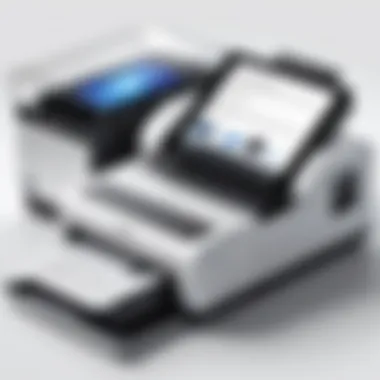
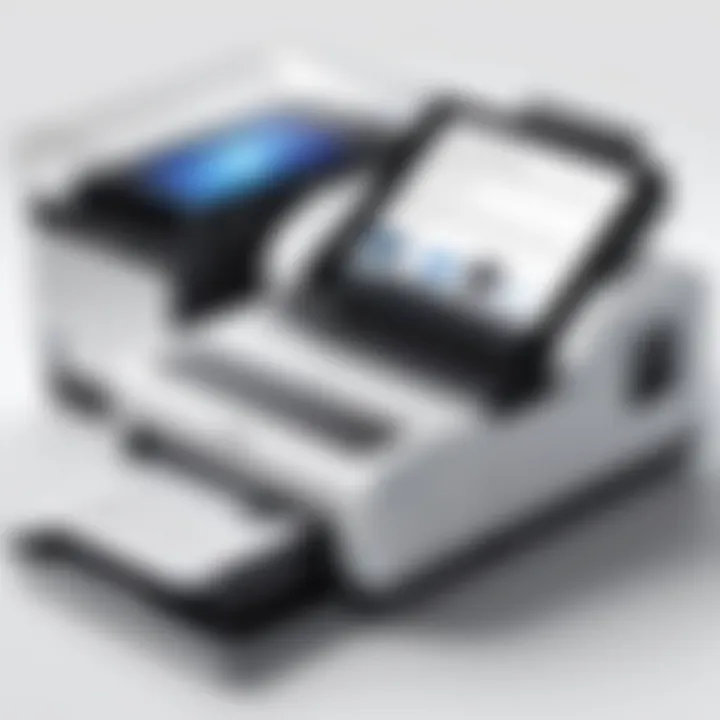
In the realm of technology, troubleshooting plays a critical role, especially when dealing with printer connectivity issues on an iPad. Understanding the common problems that users face can greatly improve user experience. An effective troubleshooting process allows users to return to productive printing quickly, enhancing their overall interaction with both their printer and iPad. When you encounter errors, it’s important to methodically address them to avoid unnecessary frustration.
Often, issues stem from simple misunderstandings about connection methods or technical requirements. Knowing how to navigate these challenges can assist users in resolving most problems on their own, saving time and potentially costly repair fees.
Printer Not Detected by iPad
One of the most frustrating issues is when an iPad does not detect a printer. This problem can arise from various reasons, including Wi-Fi connectivity issues, outdated software, or even printer settings. Here’s a step-by-step approach to diagnose this issue:
- Check Wi-Fi Connection: Ensure that both the iPad and the printer are connected to the same Wi-Fi network. If they are on different networks, the iPad may not recognize the printer.
- Software Update: Verify that the iPad’s iOS version is the latest. Navigate to Settings > General > Software Update. An outdated version can lead to compatibility problems.
- Printer Settings: Confirm that the printer is turned on and not in sleep mode. Sometimes, printers require a reset. Try turning the printer off and then back on.
- Reboot Devices: Restarting both the iPad and the printer can resolve temporary glitches.
- Reset Network Settings: If the issue persists, consider resetting the network settings on the iPad under Settings > General > Reset > Reset Network Settings.
"A clear understanding of connection protocols is key to successful device integration."
Connection Errors with USB Adapters
When utilizing USB connections, issues may also arise due to the use of adapters. Many iPads require Apple's Lightning to USB Camera Adapter or USB-C to USB Adapter for printing purposes. Errors encountered during this connection method often involve physical connectivity or compatibility:
- Adapter Differences: Ensure you are using the correct adapter for your iPad model. Verify that the adapter is functioning properly, as faulty adapters can prevent detection.
- Cable Quality: The USB cable used should be compatible and in good condition. Damaged or low-quality cables can result in unstable connections.
- Software Restrictions: Consider checking the settings on your iPad. Sometimes, privacy or app settings can block printer access.
- Printer Compatibility: Confirm that the printer supports USB functionality with the iPad. Not all printers can connect this way.
Troubleshooting AirPrint Configuration
AirPrint is a valuable feature, allowing users to print wirelessly with minimal setup. However, configuration issues may arise, leading to printing failures. Here are some essential troubleshooting tips:
- Network Confirmation: Ensure that the iPad and AirPrint-enabled printer are on the same Wi-Fi network. Any deviation can hinder communication.
- Printer Status: Check if the printer is ready to print. Look for error messages or warning lights on the printer's display.
- Restart the Print Queue: In some cases, a stuck print job may block new requests. Open the print center on the iPad and cancel any pending jobs to clear the queue.
- Firewall Settings: Occasionally, the router’s firewall settings can impede AirPrint functionality. Consider adjusting these settings if connectivity is restricted.
- Reinstall the Printer: As a last resort, remove the printer from the list of devices on the iPad and add it again. This can refresh the connection.
By understanding these common problems and their solutions, users are empowered to tackle connectivity issues with confidence.
Advanced Printing Options
In the realm of printing from an iPad, understanding advanced printing options can significantly enhance the user experience. These options provide flexibility and functionality beyond standard printing methods. With a growing inclination towards mobile computing, users are increasingly seeking ways to maximize their iPad's printing capabilities. The inclusion of advanced features can optimize workflows, especially for those who require tailored solutions for specific printing needs.
Using Third-Party Printing Apps
While iPads support various native printing solutions, third-party printing apps can greatly extend functionality. Some notable options include Printer Pro, PrintCentral Pro, and PrintBuddy.
These applications often offer:
- Enhanced File Type Support: Users can print documents from a wider range of formats, including PDF, DOCX, and even web pages.
- Improved Print Management: Many apps feature user-friendly interfaces that help track print jobs and manage queues efficiently.
- Advanced Layout Options: Customize print layouts to better fit your needs, be it booklet printing or multi-page formats.
When selecting a printing app, consider the compatibility with your printer model. Check user reviews and download stats to evaluate performance and reliability. It's also wise to assess whether these apps provide regular updates and support, ensuring longevity and security in your printing tasks.
Customizing Print Settings
Customizing print settings can dramatically impact the quality and characteristics of the printed output. iPads allow several adjustments before hitting the print button. Users can change settings such as:
- Paper Size: Choosing the appropriate paper size is essential to avoid scaling issues.
- Orientation: Select between portrait or landscape to match the document layout.
- Quality Settings: Depending on the printer model, adjust quality settings for draft or high-quality prints.
Additionally, some apps offer the option to:
- Print in grayscale or color, depending on the content.
- Include or exclude background images, which can be beneficial for documents with ornamental designs.
By leveraging these settings, users can tailor their print jobs to requirements, ensuring that the output meets their expectations. It is advisable to periodically review these customizations to align with any changes in printing needs.
Advanced printing options can be the difference between mundane print jobs and engaging, tailored documents that meet specific needs.
These insights into advanced printing options empower tech-savvy individuals, enabling efficient management of printing tasks. Understanding the nuances of apps and print settings helps users fully utilize their iPad for optimal printing performance.
Ending
In the modern world, the ability to connect your printer to an iPad represents a significant advantage for users seeking convenience and efficiency. Understanding the steps necessary for printing from your iPad not only enhances your productivity but also allows you to make full use of the technology at your disposal. This article has outlined various methods for connecting printers, from wireless options to USB connections, and highlighted the practical tools like AirPrint that streamline the process.
Recap of Key Steps to Print from iPad
To effectively print from your iPad, it is crucial to follow a structured approach. Here is a recap of the essential steps:
- Verify Compatibility: Firstly, ensure that your iPad's iOS version supports the printing capabilities of your printer. Look for AirPrint compatibility or other necessary technologies.
- Set Up Your Printer: Whether you are using a wireless or USB printer, start with the proper setup. This can involve connecting to Wi-Fi or using the correct adapter.
- Connect Your iPad: Add the printer to your iPad through the settings, making sure it appears on your device's network.
- Using Apps for Printing: Utilize compatible applications to facilitate printing tasks. Many apps feature direct printing options that can simplify your workflow.
- Troubleshoot as Needed: If you experience issues, refer to troubleshooting steps provided in this guide to resolve common connection problems.
Through careful adherence to these steps, any user can achieve a seamless printing experience from their iPad.
Future of Printing Technologies
The landscape of printing technologies continues to evolve. As more users adopt mobile devices, there is an increasing demand for solutions that cater to portable printing needs. Innovations such as cloud printing, where documents can be sent to a printer via the internet, are on the rise.
The future also holds promise for greater integration with smart home devices. Printers may soon be controllable through voice commands or even autonomous printing triggered by machine-learning algorithms based on user habits.
As technology advances, staying informed about these trends will be essential for optimizing your printing capabilities and improving overall user experience.







